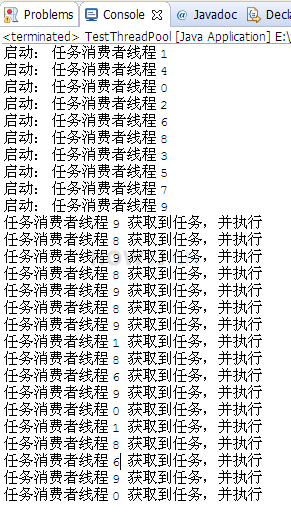Java自学-多线程 线程池
Posted 半米高峰
tags:
篇首语:本文由小常识网(cha138.com)小编为大家整理,主要介绍了Java自学-多线程 线程池相关的知识,希望对你有一定的参考价值。
Java 如何开发一个自定义线程池
每一个线程的启动和结束都是比较消耗时间和占用资源的。
如果在系统中用到了很多的线程,大量的启动和结束动作会导致系统的性能变卡,响应变慢。
为了解决这个问题,引入线程池这种设计思想。
线程池的模式很像 生产者消费者模式,消费的对象是一个一个的能够运行的任务
步骤 1 : 线程池设计思路
线程池的思路和生产者消费者模型是很接近的。
- 准备一个任务容器
- 一次性启动10个 消费者线程
- 刚开始任务容器是空的,所以线程都wait在上面。
- 直到一个外部线程往这个任务容器中扔了一个“任务”,就会有一个消费者线程被唤醒notify
- 这个消费者线程取出“任务”,并且执行这个任务,执行完毕后,继续等待下一次任务的到来。
- 如果短时间内,有较多的任务加入,那么就会有多个线程被唤醒,去执行这些任务。
在整个过程中,都不需要创建新的线程,而是循环使用这些已经存在的线程

步骤 2 : 开发一个自定义线程池
这是一个自定义的线程池,虽然不够完善和健壮,但是已经足以说明线程池的工作原理
缓慢的给这个线程池添加任务,会看到有多条线程来执行这些任务。
线程7执行完毕任务后,又回到池子里,下一次任务来的时候,线程7又来执行新的任务。

package multiplethread;
import java.util.LinkedList;
public class ThreadPool {
// 线程池大小
int threadPoolSize;
// 任务容器
LinkedList<Runnable> tasks = new LinkedList<Runnable>();
// 试图消费任务的线程
public ThreadPool() {
threadPoolSize = 10;
// 启动10个任务消费者线程
synchronized (tasks) {
for (int i = 0; i < threadPoolSize; i++) {
new TaskConsumeThread("任务消费者线程 " + i).start();
}
}
}
public void add(Runnable r) {
synchronized (tasks) {
tasks.add(r);
// 唤醒等待的任务消费者线程
tasks.notifyAll();
}
}
class TaskConsumeThread extends Thread {
public TaskConsumeThread(String name) {
super(name);
}
Runnable task;
public void run() {
System.out.println("启动: " + this.getName());
while (true) {
synchronized (tasks) {
while (tasks.isEmpty()) {
try {
tasks.wait();
} catch (InterruptedException e) {
// TODO Auto-generated catch block
e.printStackTrace();
}
}
task = tasks.removeLast();
// 允许添加任务的线程可以继续添加任务
tasks.notifyAll();
}
System.out.println(this.getName() + " 获取到任务,并执行");
task.run();
}
}
}
}.
package multiplethread;
public class TestThread {
public static void main(String[] args) {
ThreadPool pool = new ThreadPool();
for (int i = 0; i < 5; i++) {
Runnable task = new Runnable() {
@Override
public void run() {
//System.out.println("执行任务");
//任务可能是打印一句话
//可能是访问文件
//可能是做排序
}
};
pool.add(task);
try {
Thread.sleep(1000);
} catch (InterruptedException e) {
// TODO Auto-generated catch block
e.printStackTrace();
}
}
}
}步骤 3 : 测试线程池
创造一个情景,每个任务执行的时间都是1秒
刚开始是间隔1秒钟向线程池中添加任务
然后间隔时间越来越短,执行任务的线程还没有来得及结束,新的任务又来了。
就会观察到线程池里的其他线程被唤醒来执行这些任务

package multiplethread;
public class TestThread {
public static void main(String[] args) {
ThreadPool pool= new ThreadPool();
int sleep=1000;
while(true){
pool.add(new Runnable(){
@Override
public void run() {
//System.out.println("执行任务");
try {
Thread.sleep(1000);
} catch (InterruptedException e) {
// TODO Auto-generated catch block
e.printStackTrace();
}
}
});
try {
Thread.sleep(sleep);
sleep = sleep>100?sleep-100:sleep;
} catch (InterruptedException e) {
// TODO Auto-generated catch block
e.printStackTrace();
}
}
}
}步骤 4 : 使用java自带线程池
java提供自带的线程池,而不需要自己去开发一个自定义线程池了。
线程池类ThreadPoolExecutor在包java.util.concurrent下
ThreadPoolExecutor threadPool= new ThreadPoolExecutor(10, 15, 60, TimeUnit.SECONDS, new LinkedBlockingQueue<Runnable>());第一个参数10 表示这个线程池初始化了10个线程在里面工作
第二个参数15 表示如果10个线程不够用了,就会自动增加到最多15个线程
第三个参数60 结合第四个参数TimeUnit.SECONDS,表示经过60秒,多出来的线程还没有接到活儿,就会回收,最后保持池子里就10个
第四个参数TimeUnit.SECONDS 如上
第五个参数 new LinkedBlockingQueue() 用来放任务的集合
execute方法用于添加新的任务
package multiplethread;
import java.util.concurrent.LinkedBlockingQueue;
import java.util.concurrent.ThreadPoolExecutor;
import java.util.concurrent.TimeUnit;
public class TestThread {
public static void main(String[] args) throws InterruptedException {
ThreadPoolExecutor threadPool= new ThreadPoolExecutor(10, 15, 60, TimeUnit.SECONDS, new LinkedBlockingQueue<Runnable>());
threadPool.execute(new Runnable(){
@Override
public void run() {
// TODO Auto-generated method stub
System.out.println("任务1");
}
});
}
}练习: 借助线程池同步查找文件内容
在 练习-同步查找文件内容 ,如果文件特别多,就会创建很多的线程。 改写这个练习,使用线程池的方式来完成。
初始化一个大小是10的线程池
遍历所有文件,当遍历到文件是.java的时候,创建一个查找文件的任务,把这个任务扔进线程池去执行,继续遍历下一个文件
答案 :

SearchFileTask.java
package multiplethread;
import java.io.File;
import java.io.FileReader;
import java.io.IOException;
public class SearchFileTask implements Runnable{
private File file;
private String search;
public SearchFileTask(File file,String search) {
this.file = file;
this.search= search;
}
public void run(){
String fileContent = readFileConent(file);
if(fileContent.contains(search)){
System.out.printf( "线程: %s 找到子目标字符串%s,在文件:%s%n",Thread.currentThread().getName(), search,file);
}
}
public String readFileConent(File file){
try (FileReader fr = new FileReader(file)) {
char[] all = new char[(int) file.length()];
fr.read(all);
return new String(all);
} catch (IOException e) {
e.printStackTrace();
return null;
}
}
}ThreadPool.java
package multiplethread;
import java.util.LinkedList;
public class ThreadPool {
// 线程池大小
int threadPoolSize;
// 任务容器
LinkedList<Runnable> tasks = new LinkedList<Runnable>();
// 试图消费任务的线程
public ThreadPool() {
threadPoolSize = 10;
// 启动10个任务消费者线程
synchronized (tasks) {
for (int i = 0; i < threadPoolSize; i++) {
new TaskConsumeThread("任务消费者线程 " + i).start();
}
}
}
public void add(Runnable r) {
synchronized (tasks) {
tasks.add(r);
// 唤醒等待的任务消费者线程
tasks.notifyAll();
}
}
class TaskConsumeThread extends Thread {
public TaskConsumeThread(String name) {
super(name);
}
Runnable task;
public void run() {
while (true) {
synchronized (tasks) {
while (tasks.isEmpty()) {
try {
tasks.wait();
} catch (InterruptedException e) {
// TODO Auto-generated catch block
e.printStackTrace();
}
}
task = tasks.removeLast();
// 允许添加任务的线程可以继续添加任务
tasks.notifyAll();
}
task.run();
}
}
}
}TestThread.java
package multiplethread;
import java.io.File;
public class TestThread {
static ThreadPool pool= new ThreadPool();
public static void search(File file, String search) {
if (file.isFile()) {
if(file.getName().toLowerCase().endsWith(".java")){
SearchFileTask task = new SearchFileTask(file, search);
pool.add(task);
}
}
if (file.isDirectory()) {
File[] fs = file.listFiles();
for (File f : fs) {
search(f, search);
}
}
}
public static void main(String[] args) {
File folder =new File("e:\project");
search(folder,"Magic");
}
}以上是关于Java自学-多线程 线程池的主要内容,如果未能解决你的问题,请参考以下文章